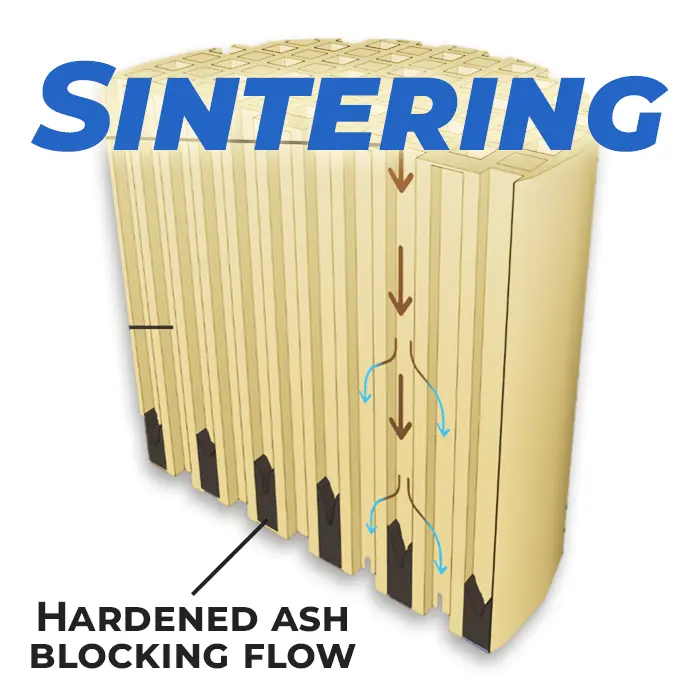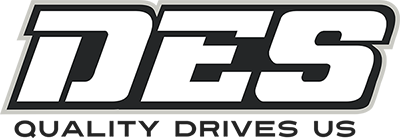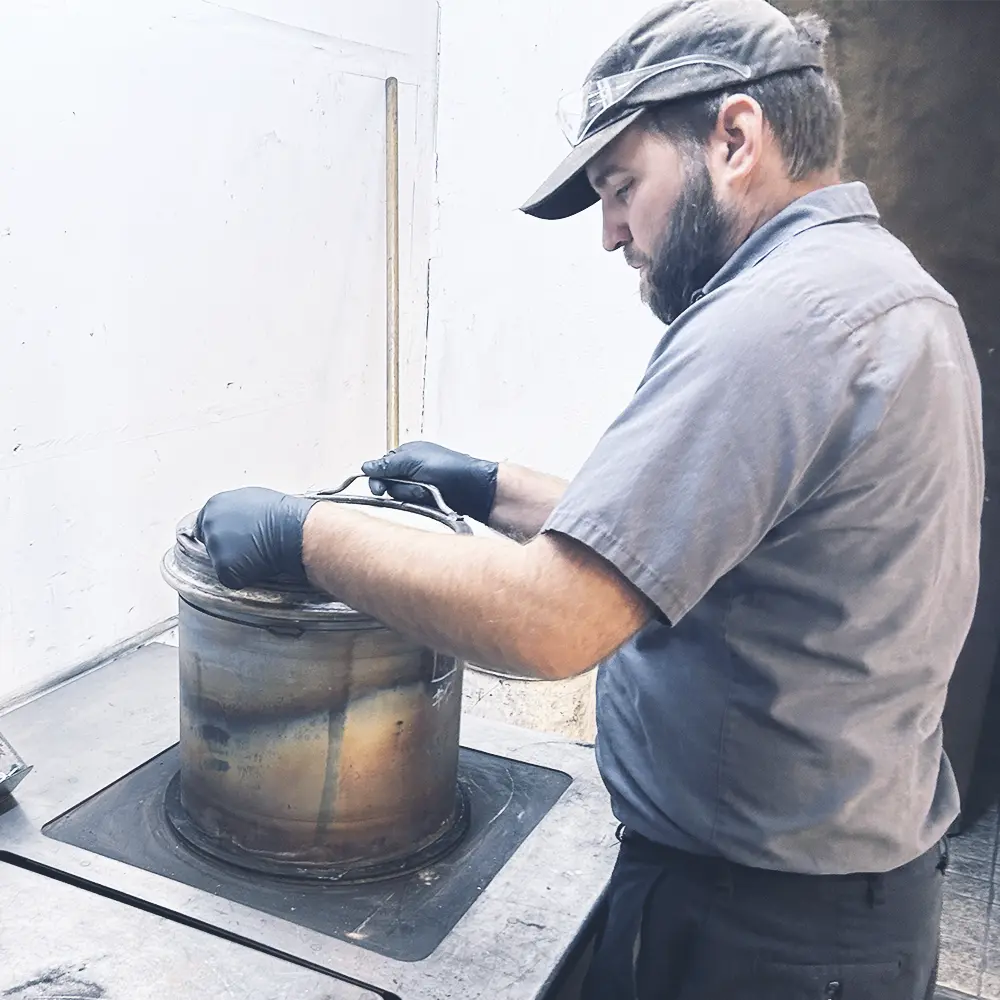DPF Cleaning: How Often?
Trucks gotta run clean! Especially here on the “left coast”.
Whatever the case may be, you might be wondering how often to clean your DPF. And where to have it done?
There are a few things to consider when setting up your plan for DPF cleaning. We will cover recommended DPF cleaning intervals, contributing factors, and common methods.
Plus we answer the age-old question “Can I just clean it myself?”
Read on!
LET'S GET STARTED!

Top 5 Factors Affecting DPF Cleaning Intervals
Ever wonder what things affect how often your DPF needs cleaning? Here are the top 5 things we’ve seen that influence DPF cleaning frequency:
-
City vs. Highway: Stop-and-go traffic and low speeds in city driving conditions can clog up your DPF much faster than highway hauls. Incomplete DPF regeneration cycles lead to more frequent cleanings. Cold weather also has an impact on DPF cleaning needs.
-
Heavy Haulers vs. Light Trucks: Big rigs, buses, and heavy machinery working hard all day tend to need DPF cleaning more often than lighter-duty trucks.
-
Watch those Fluids: Cheap oil and low-quality diesel with high sulfur can clog up your DPF with impurities. Use good quality fluids to extend DPF cleaning intervals. Keep a sharp eye out for upstream leaks in the engine that can damage the aftertreatment components.
-
Maintenance is Key: Irregular engine and DPF preventative care can cause all kinds of issues. When DPFs are neglected their efficiency and capacity decreases proportionally.
-
DPF Size: Smaller DPFs can fill up quicker than larger ones, requiring cleaning more often.
Sintering – The Silent DPF Killer: Unseen within the filter, ash can build up and sometimes hardens into a cement-like substance called “hard ash sintering”. This generally can’t be undone, reduces DPF efficiency & will lead to a filter replacement. Frequent, & properly performed DPF cleaning helps prevent sintering as does good upstream maintenance.


Recommendations for DPF Cleaning Frequency:
Keeping your truck’s Diesel Particulate Filter (DPF) clean is key to efficient operation. Nobody likes getting stranded with a derate, or worse costly repairs. But how often should you clean that DPF? There’s no magic number, but here are 5 things to consider:
-
Inspections are Key: Check your aftertreatment system and DPF regularly for signs of soot buildup. Catching it early saves you time and money.
-
The Manufacturer Knows Best (Sometimes): Your truck’s manual has recommended cleaning intervals based on its make and model. Remember, these are assuming ideal operating situations, so adjust based on your actual driving conditions.
-
Clean During Maintenance: Combining DPF cleaning into your other routine maintenance can minimize your truck’s downtime. The DPF can be cleaned while the truck is undergoing its other maintenance.
-
Warning Lights Mean Take Action: Modern trucks have DPF warning lights for a reason. Don’t ignore them! A lit light means your DPF needs attention.
-
Your Driving Matters: Stop-and-go traffic and heavy loads clog your DPF faster. If you spend a lot of time in the city or haul heavy equipment, consider more frequent cleaning. Don’t compare your cleaning schedule to others. Tailor it to how you use your truck.
At the end of the day, smart, regular DPF cleaning can help prevent those frustrating, and unexpected breakdowns.

Should I DIY or Use a DPF Cleaning Service?
These are a few of the “solutions“ that often come up when searching for How to Clean a DPF “on the cheap”:
-
Diesel Fuel Additives: These additives are mixed with your fuel to help reduce soot and ash buildup in the DPF. They can also lower the temperature needed for regeneration, making the cleaning process more efficient. Adding something to your fuel system besides fuel can be a roll of the dice. Is it worth the gamble?
-
Liquid DPF Cleaning Solutions: These products often promise to reduce soot buildup quickly and easily. They’re typically sprayed into the DPF through an access port, or the DPF might need to be removed and soaked in the solution. The aim is to loosen and dissolve soot and ash deposits, making regeneration or rinsing easier. This might work for a DPF that’s not super dirty, but if it’s clogged you might need to repeat the process multiple times or worse get poor results. There’s also the issue of proper disposal of the dirty water runoff.
-
Power-washing: This is NOT recommended! It’s very easy to damage your DPF with high water pressure. This can break apart the filter brick, damage the insulation, and remove precious metals from DOCs. Replacing a damaged filter is much more expensive than professional cleaning. Simply put, you’re taking a big risk by power-washing a DPF.

Pro-Level DPF Cleaning Methods:
Aqueous DPF Cleaning: These systems use water to wash the soot and ash from a DPF, often with a pre-soak stage. Then the filter is dried before re-installation onto a vehicle. These systems are typically faster (a few hours in most cases) than other methods and better accommodate odd-shaped units. Learn more about the Aqueous cleaning process here.
Thermal DPF Cleaning: The traditional “bake & blow” method has been around the longest. It uses high temps to burn/loosen any soot remaining in the filter to ash, once the baking process is finished – often overnight – the filter needs to be cooled down and the ash blown out of the filter. Turnaround time is usually around 24hrs. Learn about the Thermal cleaning process here.
Ultrasonic DPF Cleaning: The new kid on the block for DPF cleaning. It submerges the filter in a solution and uses sound waves to blast away ash. This method is powerful yet gentle on most filters. While effective, ultrasonic setups are expensive. Avoid cheap setups that might not be up to the task.
This article goes deeper into 3 of the main industrial-level DPF Cleaning techniques.

Why Professional DPF CLEANING matters
Pro-level DPF cleaning facilities offer high levels of expertise and equipment that provide thorough and efficient DPF cleaning. These facilities are equipped with specialized machines, such as industrial thermal ovens, pulse cleaners, aqueous cleaning systems, etc. designed to remove accumulated soot and ash effectively.
Additionally, professional technicians have experience in removing, installing, and handling all types of DPFs. They are well-trained to follow proper cleaning, safety, and inspection procedures before and after. In the long run, having your DPF cleaned by the experts saves time and money versus cleaning it yourself and potentially spending thousands of dollars on a replacement.
Parting Thoughts
In conclusion, we’ve covered the common factors, and established guidelines for how often to clean a DPF. Plus, there are several ways you can approach having your DPF cleaned.
Your truck is your livelihood, so we recommend avoiding the DIY route. The aftertreatment systems on today’s trucks are complex, precision-tuned, and interconnected. It’s best left to the professionals.
We can help you with that. At DES, we’ve cleaned thousands of DPFs over the last decade or so, up and down the West Coast. We manufacture DPF cleaning machines as well under our manufacturing brand, Filtertherm.

Diesel Emissions Services (DES) has the expertise, diesel technicians, and facilities to service your aftertreatment systems successfully.
Most of our locations feature a complete DPF Cleaning facility, aftertreatment diagnostic/testing, and a full inventory of aftertreatment parts for quick servicing of your emissions system.
We hope you found this article helpful. At DES, we believe in putting out educational and informative content to not only our customers but for the general industry to grow and benefit from.
To share this article, use one of the social media icons above.


